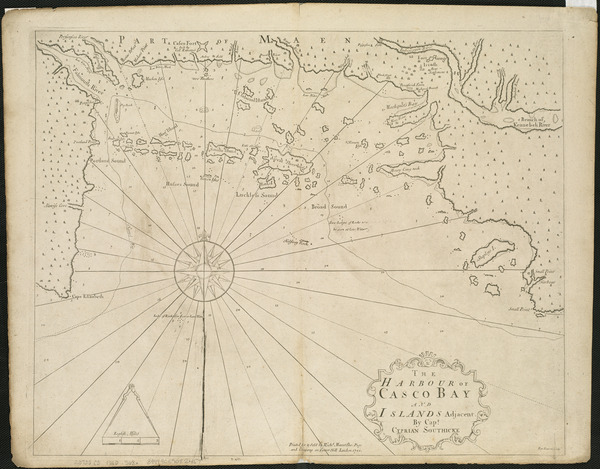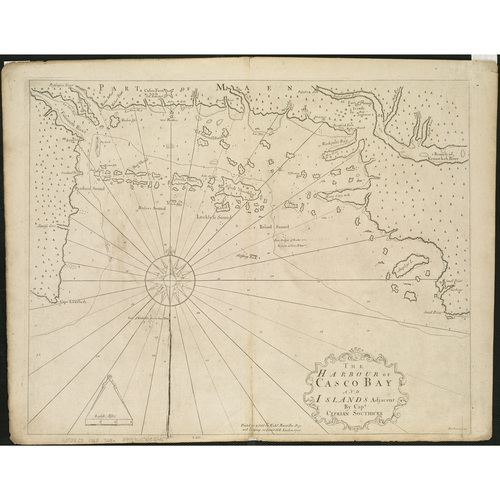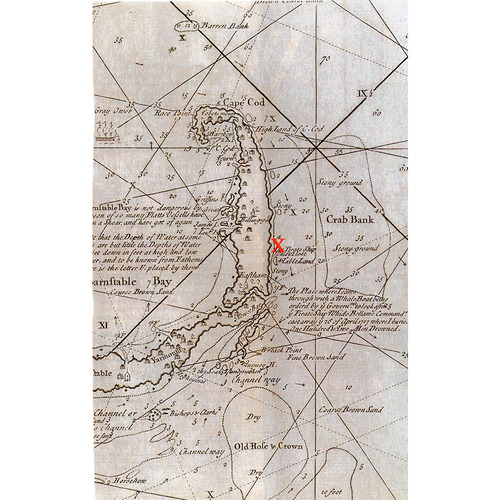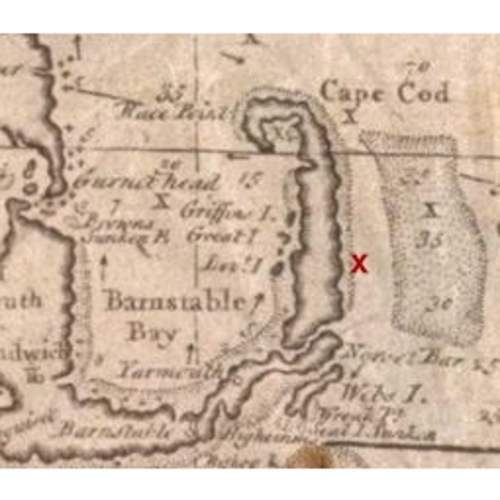
Source: Courtesy of Wikimedia Commons
SOUTHACK, CYPRIAN, cartographer, naval commander, member of the Nova Scotia Council; b. 1662 in London, England, son of Cyprian Southack and Elizabeth Oakley; m. Elizabeth Foy, by whom he had 11 children; d. 27 March 1745 (o.s.) in Boston, Massachusetts.
Following in the footsteps of his father, a naval lieutenant under Charles II, Cyprian Southack went to sea. At the age of ten he was present at a battle between Anglo-French and Dutch fleets at Southwold Bay. He went to Boston in 1685, and soon became well known as a cartographer and privateer. He entered the service of the colony of Massachusetts in 1690, when the man-of-war Mary, of which he was commander and part-owner, was rented for use in the expedition against Port-Royal (Annapolis Royal, N.S.) under Sir William Phips*. After the capture of Port-Royal, Southack went to Cape Sable Island, where he combatted Indians allied to the French; to Chedabouctou (Guysborough, N.S.), where he reduced Fort Saint-Louis [see Charles Duret* de Chevry]; and to Newfoundland, where he raided French outposts. These missions mark the beginning of a long period of employment for Southack by the Massachusetts government.
In March 1692 Southack was sent by the Massachusetts government to the Bay of Fundy (Baie Française), accompanied by Captain John Alden*, to pursue a French privateer – possibly Pierre Maisonnat* – operating in the area. Later that year he was given orders to cruise in Massachusetts Bay and east to Casco (Maine) to protect shipping. In the summer of 1696 he was appointed commander of the first Province Galley, a small vessel of ten guns built in 1694 by order of the Massachusetts General Court to deal with French and Indian problems. This vessel was replaced in 1705 by the second Province Galley, (16–18 guns), which Southack commanded until 1714.
As commander of these vessels, Southack guarded the coasts and shipping of New England against French incursions, represented Massachusetts in its dealings with the Indians on the northern frontier of the colony, and tried to suppress illegal trade with the French. In 1696 he participated in a futile attack on Governor Joseph Robinau* de Villebon’s headquarters on the Saint John River. He took part in other expeditions against Acadia in 1704 and 1707, under Benjamin Church* and John March* respectively, and played a major role in helping to save the settlement of Casco when it was attacked by French forces under Alexandre Leneuf* de La Vallière et de Beaubassin in 1703. In 1710 he commanded the Province Galley in the successful expedition against Port-Royal under Francis Nicholson*. During this period he also produced charts of the New England coast, the Saint John River, and the St Lawrence River.
In 1711, probably because of his experience as a map-maker and mariner, Southack was asked to guide the expedition against Quebec under Sir Hovenden Walker* up the St Lawrence. While the fleet was being readied in Boston, Walker was lodged with Southack so that he might avail himself of Southack’s knowledge of the route to Quebec. Southack, however, was reluctant to accompany the expedition in spite of Walker’s entreaties. Eventually he was sent to Annapolis Royal to pick up men and supplies. He was supposed to join the fleet en route to Quebec, but was delayed at Annapolis and could not do so. At the conclusion of Queen Anne’s War in 1713, Southack was sent to Nova Scotia to notify French privateers of the end of the conflict. His efforts ended with the loss of his sloop, worth £200, to privateers at either Cape Sable Island or Port La Tour. In the next few years he was a member of several government missions. He accompanied Thomas Smart* to Île Royale (Cape Breton Island) in 1718 to confer with Governor Saint-Ovide [Monbeton] about French encroachments on the Canso fishery. In the same year he was in Quebec as a commissioner in an attempt to resolve the disputed boundary of Nova Scotia. Early in 1720 he sought a further appointment as a boundary commissioner and requested a pension in recognition of his services.
In April 1720 Southack was appointed to the first council of Nova Scotia. He attended the first few meetings of the council that year, but then returned to naval service. In August 1721, as commander of the William Augustus, he transported Governor Richard Philipps and Paul Mascarene to Canso. The next spring the William Augustus was used for a ten-day survey of the coast north of Canso; it is not known whether Southack himself did the surveying. The survey was resumed later that year, but was disrupted by Indian troubles – possibly by attacks on New England fishing vessels. Southack sailed again in 1723, but the William Augustus was laid up later that year. In 1724 Major Lawrence Armstrong* asked for the replacement of Southack and several other absent members of the council.
By 1724 Southack seems to have retired from public service, and may then have confined his activities to his commerical interests, which had been extensive. From being part-owner of a privateering vessel in 1690 he progressed to fishing, and, on at least one occasion, the sale of building materials. Fishing off Nova Scotia, however, was a hazardous undertaking. In 1715 Southack was threatened with the loss of his life by Indians while fishing at Port Roseway (Roseway, N.S.), and he was forced to flee, suffering a loss of £600. In 1718 he had a fishing sloop worth £300 burned by Indians when it went aground. That year he claimed to have lost a total often sloops over the years worth £6,000. He was also involved in the fishery at Canso, where he held property in 1725 and probably earlier.
Southack’s activities after 1724 are obscure. He seems to have remained active in King’s Chapel (Boston) as late as 1739, when he last served as an officer of the church, ending a period of service which began about 1702. In 1733 he was ordered by a committee of Boston selectmen to make improvements in his property to avoid danger to the public. This is not an indication that was impoverished, for when he died in 1745 he left an estate of over £3,600.
American Antiquarian Soc. (Worcester, Mass.), Edmonds papers, miscellaneous mss and letters. “Mass. Archives,” II, 639, 643; VII, 141, 148, 163, 198, 336, 345, 382; XI, 430; XXXVI, 6a, 28, 127; XXXVII, 328, 390a; XXXVIIIA, 8, 16–18; LXI, 506; CXIV, 136. Mass. Hist. Soc., Gay papers, N.S., II, 91, 117. PANS, RG 1, 9, no.10; 18, nos.5, 17, 26, 28; 23, nos.1–10. “Journal of Colonel Nicholson at the capture of Annapolis, 1710,” N.S. Hist. Soc. Coll., I (1878), 65. Mass. Hist. Soc. Proc., 3rd ser., VII (1914), 154, 155. PRO, CSP, Col., 1689–92 to 1724–25. Walker expedition (Graham). Bibliotheca Americana: a dictionary of books relating to America from its discovery to the present time, ed. Joseph Sabin et al. (29v., New York, 1868–1936), XXII, 341. DAB (biography of Southack; gives some details on his maps). Annals of King’s Chapel from the Puritan age of New England to the present day, ed. H. W. Foote et al. (2v., Boston, 1882–96), I, 176, 177, 193, 211, 230, 242, 246, 351, 360, 401; II, 603, 605.
H. M. Chapin, Privateer ships and sailors: the first century of American colonial privateering, 1625–1725 (Toulon, Ill., 1926). S. G. Drake, The history and antiquities of Boston from its settlement in 1630, to the year 1770 (Boston, 1856), 539, 593. H. A. Hill, History of the old South Church (Third Church), Boston, 1669–1884 (2v., Boston, 1890), I, 282. McLennan, Louisbourg. The memorial history of Boston, including Suffolk County, Massachusetts, 1630–1880, ed. Justin Winsor (4v., Boston, 1880–81), II, 104, 541. Murdoch, History of Nova-Scotia, II, 269–71, 307, 357, 363, 404. Privateering and piracy in the colonial period: illustrative documents, ed. J. F. Jameson (New York, 1923), 291. Elizabeth Reynard, The narrow land; folk chronicles of old Cape Cod (Boston, New York, 1934), 239, 241, 244. G. M. Waller, Samuel Vetch, colonial enterpriser (Chapel Hill, N.C., 1960). S. C. Clough, “Notes on Cotton Hill and adjacent estates, 1650–1750,” Col. Soc. Mass. Pubs., XX (1920), 266–67. H. C. Hart, “History of Canso, Guysborough County, N.S.,” N.S. Hist. Soc. Coll., XXI (1927), 11. Samuel Niles, “A summary historical narrative of the wars of New-England with the French and Indians, in the several parts of the country,” Mass. Hist. Soc. Coll., 3rd ser., VI (1837), 249; 4th ser., V (1861), 344. H. S. Tapley, “The Province Galley of Massachusetts Bay, 1694–1716,” Essex Institute (Salem, Mass.), Hist. Coll., LVIII (1922), 73–74, 82, 84.
Cite This Article
Donald F. Chard, “SOUTHACK, CYPRIAN,” in Dictionary of Canadian Biography, vol. 3, University of Toronto/Université Laval, 2003–, accessed April 24, 2025, https://www.biographi.ca/en/bio/southack_cyprian_3E.html.
The citation above shows the format for footnotes and endnotes according to the Chicago manual of style (16th edition). Information to be used in other citation formats:
| Permalink: | https://www.biographi.ca/en/bio/southack_cyprian_3E.html |
| Author of Article: | Donald F. Chard |
| Title of Article: | SOUTHACK, CYPRIAN |
| Publication Name: | Dictionary of Canadian Biography, vol. 3 |
| Publisher: | University of Toronto/Université Laval |
| Year of revision: | 1974 |
| Access Date: | April 24, 2025 |





